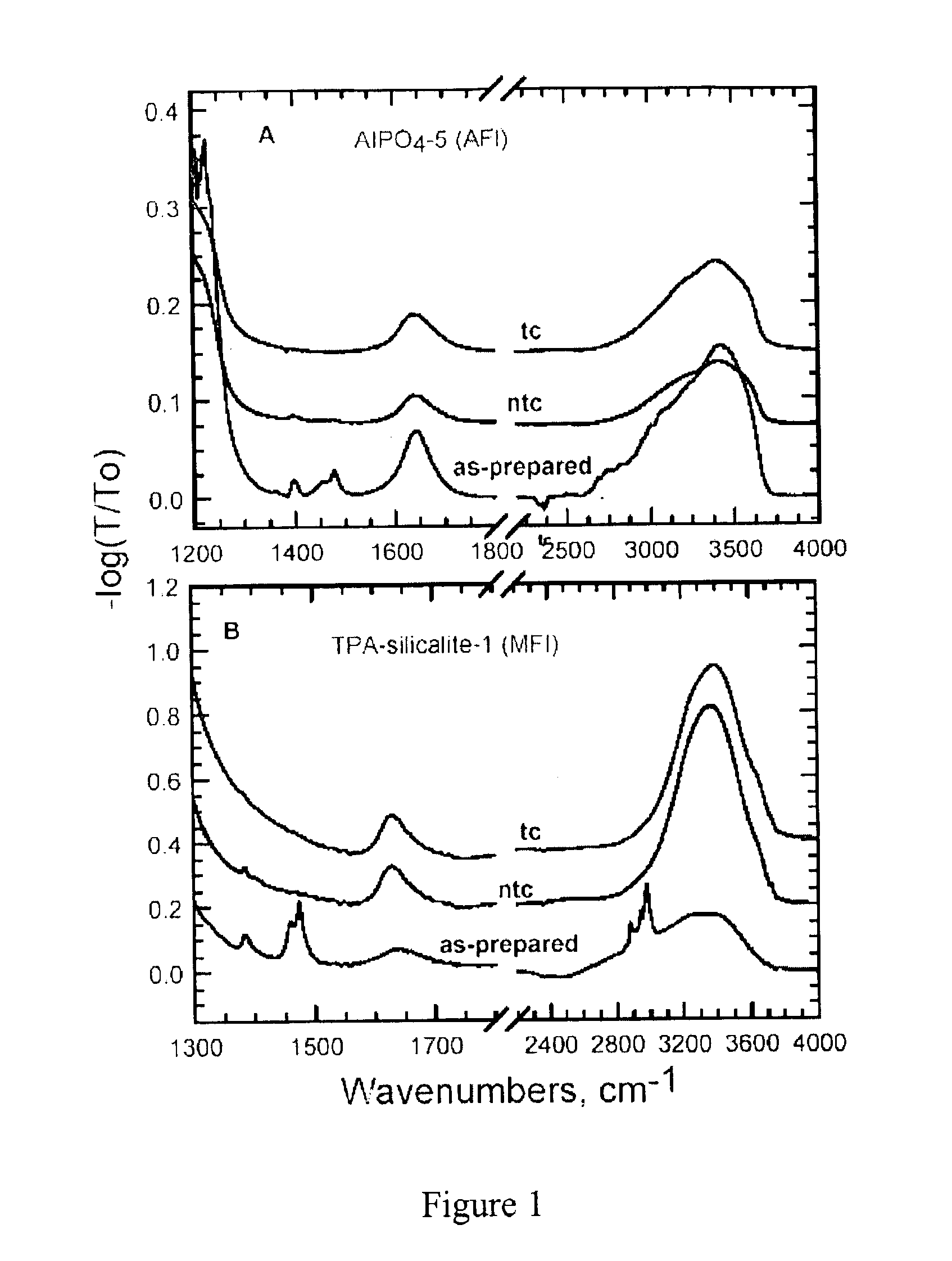Methods for removing organic compounds from nano-composite materials
- Summary
- Abstract
- Description
- Claims
- Application Information
AI Technical Summary
Benefits of technology
Problems solved by technology
Method used
Image
Examples
example 1
[0085]This example illustrates a method for producing silicalite and aluminophosphate nano-composite materials using organic molecules as templates.
[0086]Using the procedures described in Persson et al., Zeolites, 1994, 14, 557-567, and U.S. Pat. No. 4,310,440, issued to Wilson et al., silicalite and aluminophosphate nano-composite materials, respectively, were prepared as follows.
[0087]Tetrapropylammonium silicalite zeolite (i.e., TPA-silicalite-1 or MFI zeolite) was synthesized by reacting the initial synthetic mixture with the composition 25 SiO2:480 H2O:9 TPAOH:100 ethanol at 80° C. for 72 h. The synthetic mixture was prepared by vigorously stirring 119.10 g of 10% TPAOH solution (Fisher), 30.32 g of 40% TPAOH solution (Alfa), and 68.4 g of tetraethylorthosilicate (TEOS, Alfa) at room temperature for 2-3 h untill homogeneous and optically clear.
[0088]AlPO4-5 was similarly prepared by reacting a synthetic mixture of composition 1.5 tripropylamine:Al2O3:P2O5:40 H2O at 150° C. for ...
example 2
[0089]This example illustrates a method for removing organic molecules from the nano-composite materials using light.
[0090]The nano-composite materials from Example 1 above were irradiated with UV light (λ=184-257 nm) produced by a low or medium pressure Hg discharge lamp in a quartz envelope. The lamp was maintained in a closed chamber under ambient laboratory conditions. In some instances, oxygen was introduced to accelerate removal of the organic compound from the nano-composite material. Samples were spread loosely on a clean glass slide or a silicon wafer inside the UV chamber.
[0091]The exposure time required for substantially complete removal of the organic compound depended on a variety of factors, such as the lamp power, cleanliness of the lamp, presence of added oxygen, and the distance of the sample from the lamp. Typically, however, the exposure time ranged from about 30 to about 60 h. The organic compound removal progress was monitored, for example, using Fourier Transfo...
example 3
[0092]This example illustrates a method for preparing a nano-composite silicate material comprising germanium.
[0093]Using the procedure described by Corma et al., Chem. Commun., 2001, 20, 2148-2149, ITQ-7 exhibiting a Si / Ge-ratio of 5 was synthesized with a material composition of 0.833 SiO2:0.167 GeO2:0.50 C14H26NOH:0.5 HF:3 H2O where C14H26NOH (i.e. 1,3,3-trimethyl-6-azoniumtricyclo [3.2.1.46,6] dodecane hydroxide) is used as the SDA.
PUM
| Property | Measurement | Unit |
|---|---|---|
| Temperature | aaaaa | aaaaa |
| Temperature | aaaaa | aaaaa |
| Temperature | aaaaa | aaaaa |
Abstract
Description
Claims
Application Information
 Login to View More
Login to View More - R&D
- Intellectual Property
- Life Sciences
- Materials
- Tech Scout
- Unparalleled Data Quality
- Higher Quality Content
- 60% Fewer Hallucinations
Browse by: Latest US Patents, China's latest patents, Technical Efficacy Thesaurus, Application Domain, Technology Topic, Popular Technical Reports.
© 2025 PatSnap. All rights reserved.Legal|Privacy policy|Modern Slavery Act Transparency Statement|Sitemap|About US| Contact US: help@patsnap.com



